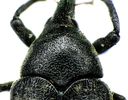Lixinae
Lixinae
Classification
- Phylum: Arthropoda
- Subphylum: Hexapoda
- Class: Insecta
- Order: Coleoptera
- Suborder: Polyphaga
- Superfamily: Curculionoidea
- Family: Curculionidae
- Subfamily: Lixinae
Pronunciation
How to pronounce Lixinae: /ˈlɪksɪniː/
These audio files are automatically generated. While they are not always 100% accurate, they are a good starting point.
Images






Summary
Lixinae is a subfamily of true weevils mainly consisting of root feeders; some are important in biological control of weeds, particularly in Western North America. Their presence in diverse habitats and distinctive physical traits allow for differentiation from other beetle families.
Physical Characteristics
Body is elongate in shape, tarsal claws fused at the base, short and telescoping labial palps, and each tibia bears a distal uncus (small hook) with a forwardly directed rostrum.
Identification Tips
Look for tarsal claws fused at the base, an elongate body shape, and check for the rostrum orientation.
Habitat
Usually associated with mesic habitats; members of Cleonini found more in arid habitats, while Lixini prefer more mesic conditions.
Distribution
Approximately 110 species in North America, with about 1,500 species worldwide. Much more diverse in drier regions of the Old World.
Diet
Larvae mine stems or roots; some species, like Rhinocyllus, Larinus, and Microlarinus, feed in flower heads or on seeds.
Ecosystem Role
Some species are used for biological control of invasive weeds, such as knapweeds (Centaurea).
Economic Impact
Several species introduced for weed control, impacting agricultural practices.
Evolution
Believed to have originated in Euroasian lands when the Tethys Ocean diminished, with adaptations occurring in arid conditions of the Ancient Mediterranean.
Similar Taxa
- Cleoninae
- Curculionidae
Misconceptions
Some older classifications included this group under Molytinae, leading to confusion in taxonomical rankings.
Tags
- Lixinae
- weevils
- biological control
- invasive species
- mesic habitats
- economic impact